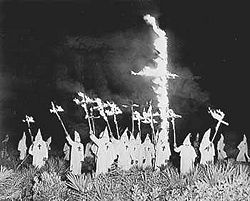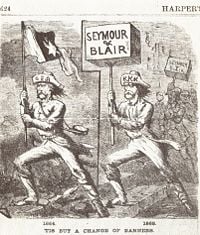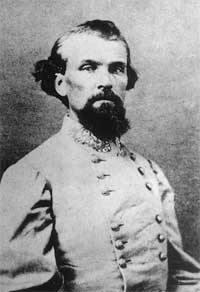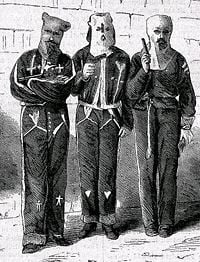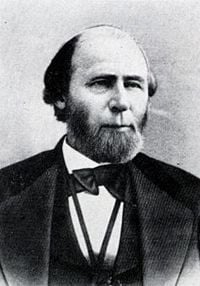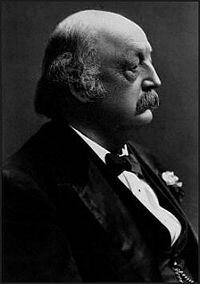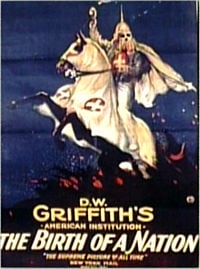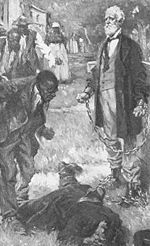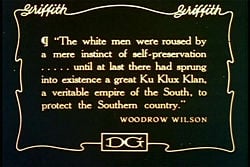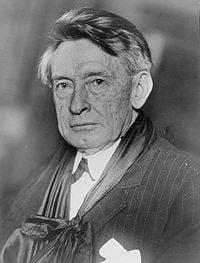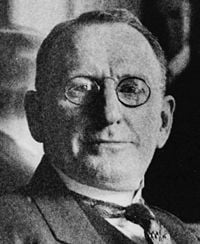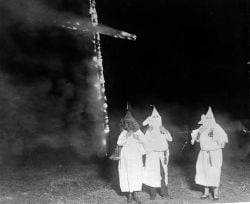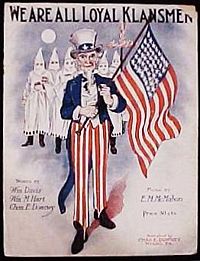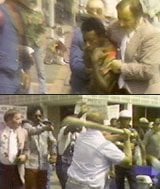Ku Klux Klan
Ku Klux Klan (KKK) is the name of several past and present organizations in the United States that have advocated at different times white supremacy, anti-Semitism, racism, anti-Catholicism, homophobia, and nativism. These organizations have often used terrorism, violence and acts of intimidation to oppress Black Americans and other groups.
The Klan's first appearance was shortly after the American Civil War in 1866. It was founded by veterans of the Confederate Army, with the purpose of resisting Reconstruction efforts. The organization focused as much on intimidating "carpetbaggers" and "scalawags" as on restricting the freedoms of the newly emancipated slaves. The organization fell into decline from 1868 to 1870 and was destroyed in the early 1870s by President Ulysses S. Grant's vigorous enforcement of the Civil Rights Act of 1871 also known as the Ku Klux Klan Act.
In 1915, a second distinct group was founded using the same name. Inspired by the newfound power of the modern mass media, the film The Birth of a Nation, and inflammatory anti-Semitic newspaper accounts surrounding the trial and lynching of accused murderer Leo Frank, the second incarnation of the KKK was designed as a formal fraternal organization. In 1924 at the Democratic National Convention in New York City it fully flexed its political clout with presidential hopeful William G. McAdoo against Alfred E. Smith. The Democrats eventually chose a third man, John W. Davis, but America came tenuously close to having a known Klansman as a presidential candidate. The Klan's popularity fell after the convention and continued its slide during economic leveling of the Great Depression. Membership fell further during World War II, because of scandals resulting from prominent members' crimes and its support of the German Nazis.
The name "Ku Klux Klan" has been used ever since this time by many different groups, including those who opposed desegregation in the 1950s and the 1960s. Members of these groups were convicted of murder and manslaughter in the deaths of Civil Rights workers and children. Contemporary groups, organized into independent, small local units, are considered extreme hate groups. The modern KKK has been repudiated by all mainstream media and American political and religious leaders.
Creation of First Klan
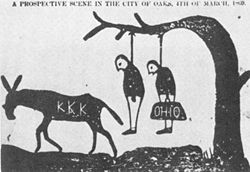
The original Ku Klux Klan was created after the end of the American Civil War on December 24, 1865, by six educated, middle-class Confederate veterans.[1] These founders were John C. Lester, John B. Kennedy, James R. Crowe, Frank O. McCord, Richard R. Reed, and J. Calvin Jones from Pulaski, Tennessee, who reportedly were bored with postwar routine. The name was constructed by combining the Greek "kyklos" (ΞΊΟ ΞΊΞ»Ξ¬Ο, circle) with "clan"[2]
The Ku Klux Klan soon spread into nearly every southern state, launching a "reign of terror" against Republican leaders both black and white. Those assassinated during the campaign included Arkansas Congressman James M. Hinds, three members of the South Carolina legislature, and several men who had served in constitutional conventions."[3]
In 1867, at a meeting in Nashville, Tennessee an effort was made to create a hierarchical organization with local chapters reporting to county leaders, counties reporting to districts, districts reporting to states, and states reporting to a national headquarters. The proposals, in a document called the "Prescript," were written by George Gordon, a former Confederate brigadier general. The Prescript included inspirational language about the goals of the Klan along with a list of questions to be asked of applicants for membership, which confirmed the focus on resisting Reconstruction and the Republican Party.[4]
Despite the work that came out of the 1867 meeting, the Prescript was never accepted by any of the local units. They continued to operate autonomously, and there never were county, district, or state headquarters.
Activities
The Klan sought to control the political and social status of the freed slaves. Specifically, it attempted to curb black education, economic advancement, voting rights, and the right to bear arms. However, although the Klan's focus was mainly African Americans, Southern Republicans also became the target of vicious intimidation tactics. The violence achieved its purpose. For example, in the April 1868 Georgia gubernatorial election, Columbia County cast 1,222 votes for Republican Rufus Bullock, but in the November presidential election, the county cast only one vote for Republican candidate Ulysses Grant.[5]
Klan intimidation was often targeted at schoolteachers and operatives of the federal Freedmen's Bureau. Black members of the Loyal Leagues were also the frequent targets of Klan raids. In a typical episode in Mississippi, according to the Congressional inquiry[6]
One of these teachers (Miss Allen of Illinois), whose school was at Cotton Gin Port in Monroe County, was visited β¦ between one and two o'clock in the morning on March, 1871, by about 50 men mounted and disguised. Each man wore a long white robe and his face was covered by a loose mask with scarlet stripes. She was ordered to get up and dress which she did at once and then admitted to her room the captain and lieutenant who in addition to the usual disguise had long horns on their heads and a sort of device in front. The lieutenant had a pistol in his hand and he and the captain sat down while eight or ten men stood inside the door and the porch was full. They treated her "gentlemanly and quietly" but complained of the heavy school-tax, said she must stop teaching and go away and warned her that they never gave a second notice. She heeded the warning and left the county.
In other violence, Klansmen killed more than 150 African Americans in a single county in Florida, and hundreds more in other counties.[7]
An 1868 proclamation by Gordon demonstrates several of the issues surrounding the Klan's violent activities.[8]
- Many black men were veterans of the Union Army and were armed. From the beginning, one of the original Klan's strongest focuses was on confiscating firearms from blacks. In the proclamation, Gordon warned that the Klan had been "fired into three times," and that if the blacks "make war upon us they must abide by the awful retribution that will follow."
- Gordon also stated that the Klan was a peaceful organization. Such claims were common ways for the Klan to attempt to protect itself from prosecution. However, a federal grand jury in 1869 determined that the Klan was a "terrorist organization." Hundreds of indictments for crimes of violence and terrorism were issued. Klan members were prosecuted, and many fled jurisdiction, particularly in South Carolina.[9]
- Gordon warned that some people had been carrying out violent acts in the name of the Klan. It was true that many people who had not been formally inducted into the Klan found the Klan's uniform to be a convenient way to hide their identities when carrying out acts of violence. However, it was also convenient for the higher levels of the organization to disclaim responsibility for such acts, and the secretive, decentralized nature of the Klan made membership difficult to prove. In many ways the Klan was a military force serving the interests of the Democratic Party, the planter class, and those who desired the restoration of white supremacy.[10]
By 1868, only two years after the Klan's creation, its activity was already beginning to decrease[11] and, as Gordon's proclamation shows, to become less political and more simply a way of avoiding prosecution for violence. Many influential southern Democrats were beginning to see it as a liability, an excuse for the federal government to retain its power over the South.[12] Georgian B.H. Hill went so far as to claim "that some of these outrages were actually perpetrated by the political friends of the parties slain."[13]
Decline and suppression
The first Klan was never centrally organized. As a secret or "invisible" group, it had no membership rosters, no dues, no newspapers, no spokesmen, no chapters, no local officers, no state or national officials. Its popularity came from its reputation, which was greatly enhanced by its outlandish costumes and its wild and threatening theatrics. As historian Elaine Frantz Parsons discovered:[14]
Lifting the Klan mask revealed a chaotic multitude of anti-black vigilante groups, disgruntled poor white farmers, wartime guerrilla bands, displaced Democratic politicians, illegal whiskey distillers, coercive moral reformers, bored young men, sadists, rapists, white workmen fearful of black competition, employers trying to enforce labor discipline, common thieves, neighbors with decades-old grudges, and even a few freedmen and white Republicans who allied with Democratic whites or had criminal agendas of their own. Indeed, all they had in common, besides being overwhelmingly white, southern, and Democratic, was that they called themselves, or were called, Klansmen.
Forrest's national organization had little control over the local Klans, which were highly autonomous. Forrest ordered the Klan to disband in 1869, stating that it was "being perverted from its original honorable and patriotic purposes, becoming injurious instead of subservient to the public peace."[15] Because of the national organization's lack of control, this proclamation was more a symptom of the Klan's decline than a cause of it. Historian Stanley Horn writes that "generally speaking, the Klan's end was more in the form of spotty, slow, and gradual disintegration than a formal and decisive disbandment."[16] A reporter in Georgia wrote in January 1870 that "A true statement of the case is not that the Ku Klux are an organized band of licensed criminals, but that men who commit crimes call themselves Ku Klux."[17]
Although the Klan was being used more often as a mask for nonpolitical crimes, state and local governments seldom acted against it. In lynching cases, whites were almost never indicted by all-white coroner's juries, and even when there was an indictment, all-white trial juries were unlikely to vote for conviction. In many states, there were fears that the use of black militiamen would ignite a race war.[18] When Republican Governor of North Carolina William Woods Holden called out the militia against the Klan in 1870, the result was a backlash that led to Republicans losing their majority in the legislature, and ultimately, to his own impeachment and removal from office.[19]
Despite this power, there was resistance to Klan terror. "Occasionally, organized groups successfully confronted the Klan. White Union Army veterans in mountainous Blount County, Alabama, organized 'the anti-Ku Klux,' which put an end to violence by threatening Klansmen with reprisals unless they stopped whipping Unionists and burning black churches and schools. Armed blacks patrolled the streets of Bennettsville, South Carolina, to prevent Klan assaults."[20]
There was also a national movement to crack down on the Klan, even though many Democrats at the national level questioned whether the Klan even existed or was just a creation of nervous Republican governors in the South.[21] In January 1871, Pennsylvania Republican Senator John Scott convened a committee which took testimony from 52 witnesses about Klan atrocities. Many southern states had already passed anti-Klan legislation, and in February Congressman (and former Union General) Benjamin Franklin Butler of Massachusetts (who was widely reviled by Southern whites) introduced federal legislation modeled on it.[22] The tide was turned in favor of the bill by the Governor of South Carolina's appeal for federal troops, and by reports of a riot and massacre in a Meridian, Mississippi, courthouse, from which a black state representative escaped only by taking to the woods.[23]
In 1871, President Ulysses S. Grant signed Butler's legislation, the Ku Klux Klan Act, which was used along with the 1870 Force Act to enforce the civil rights provisions of the constitution. Under the Klan Act, federal troops were used rather than state militias, and Klansmen were prosecuted in federal court, where juries were often predominantly black.[18] Hundreds of Klan members were fined or imprisoned, and habeas corpus was suspended in nine counties in South Carolina. These efforts were so successful that the Klan was destroyed in South Carolina[24] and decimated throughout the rest of the country. The tapering off of the federal government's actions under the Klan Act, ca. 1871β74, went along with the final extinction of the Klan,[25] although in some areas similar activities, including intimidation and murder of black voters, continued under the auspices of local organizations such as the White League, Red Shirts, saber clubs, and rifle clubs.[26]
It took several more years for all Klan elements to be destroyed. On Easter Sunday, 1873, the bloodiest single instance of racial violence in the Reconstruction era happened during the Colfax massacre. The massacre began when black citizens fought back against the Klan and its allies in the White League. As Louisiana black teacher and legislator John G. Lewis later remarked, "They attempted (armed self-defense) in Colfax. The result was that on Easter Sunday of 1873, when the sun went down that night, it went down on the corpses of two hundred and eighty negroes."[27][28]
Second Klan
In the four and a half decades after the suppression of the first Ku Klux Klan, race relations in the United States remained very badβthe nadir of American race relations is often placed in this era, and according to Tuskegee Institute, the 1890s was the peak decade for lynchings.
Creation
The founding of the second Ku Klux Klan in 1915 demonstrated the newfound power of modern mass media. Three closely related events sparked the resurgence:
- The film The Birth of a Nation was released, mythologizing and glorifying the first Klan.
- Leo Frank, a Jewish man accused of the rape and murder of a young white girl named Mary Phagan, was lynched against a backdrop of media frenzy.
- The second Ku Klux Klan was founded with a new anti-immigrant, anti-Catholic, and anti-Semitic agenda. The bulk of the founders were from an organization calling itself the Knights of Mary Phagan, and the new organization emulated the fictionalized version of the original Klan presented in The Birth of a Nation.
Filmmaker D. W. Griffith's The Birth of a Nation glorified the original Klan, which was by then a fading memory. His film was based on the book and play The Clansman and the book The Leopard's Spots, both written by Thomas Dixon. The film created a nationwide craze for the Klan. At a preview in Los Angeles, actors dressed as Klansmen were hired to ride by as a promotional stunt, and real-life members of the newly reorganized Klan rode up and down the street at its later official premiere in Atlanta. In some cases, enthusiastic southern audiences fired their guns into the screen.[29]
Much of the modern Klan's iconography, including the standardized white costume and the burning cross, are imitations of the film, whose imagery was based on Dixon's romanticized concept of old Scotland as portrayed in the novels and poetry of Sir Walter Scott, rather than on the Reconstruction Klan.
The film's popularity and influence were enhanced by a widely reported endorsement of its factual accuracy by historian and U.S. President Woodrow Wilson as a favor to an old friend. The Birth of a Nation includes extensive quotations from Woodrow Wilson's History of the American People, for example, "The white men were roused by a mere instinct of self-preservation β¦ until at last there had sprung into existence a great Ku Klux Klan, a veritable empire of the South, to protect the Southern country."[30] Wilson, on seeing the film in a special White House screening on February 18 1915, exclaimed, "It is like writing history with lightning, and my only regret is that it is all so terribly true."[31] Wilson's family had sympathized with the Confederacy during the Civil War and cared for wounded Confederate soldiers at a church. When he was a young man, his party had vigorously opposed Reconstruction, and as president he resegregated the federal government for the first time since Reconstruction.
Given the film's strong Democratic partisan message and Wilson's documented views on race and the Klan, it is not unreasonable to interpret the statement as supporting the Klan, and the word "regret" as referring to the film's depiction of Radical Republican Reconstruction. Later correspondence with Griffith, the film's director, confirms Wilson's enthusiasm about the film. Wilson's remarks were widely reported and immediately became controversial. Wilson tried to remain aloof from the controversy, but finally, on April 30, he issued a non-denial denial.[32] His endorsement of the film greatly enhanced its popularity and influence, and helped Griffith to defend it against legal attack by the NAACP; the film, in turn, was a major factor leading to the creation of the second Klan.
In the same year, an important event in the coalescence of the second Klan was the lynching of Leo Frank, a Jewish factory manager. In sensationalistic newspaper accounts, Frank was accused of fantastic sexual crimes and of the murder of Mary Phagan, a girl employed at his factory. He was convicted of murder after a questionable trial in Georgia (the judge asked that Frank and his counsel not be present when the verdict was announced because of the violent mob of people surrounding the court house). His appeals failed (Supreme Court Justice Oliver Wendell Holmes dissented, condemning the intimidation of the jury as failing to provide due process of law). The governor then commuted his sentence to life imprisonment, but a mob calling itself the "Knights of Mary Phagan" kidnapped Frank from the prison farm and lynched him. Ironically, much of the evidence in the murder actually pointed to the factory's black janitor, Jim Conley, who the prosecution claimed only helped Frank to dispose of the body.
For many southerners who believed Frank to be guilty, there was a strong resonance between the Frank trial and The Birth of a Nation, because they saw an analogy between Mary Phagan and the film's character Flora, a young virgin who throws herself off a cliff to avoid being raped by the black character Gus, described as "a renegade, a product of the vicious doctrines spread by the carpetbaggers."
The Frank trial was used skillfully by Georgia politician and publisher Thomas E. Watson, the editor for The Jeffersonian magazine at the time and later a leader in the reorganization of the Klan who was later elected to the U.S. Senate. The new Klan was inaugurated in 1915 at a meeting led by William J. Simmons on top of Stone Mountain, and attended by aging members of the original Klan, along with members of the Knights of Mary Phagan.
Simmons found inspiration for this second Klan in the original Klan's "Prescripts," written in 1867 by George Gordon in an attempt to give the original Klan a sense of national organization.[33] The Prescript states as the Klan's purposes:[34]
- First: To protect the weak, the innocent, and the defenseless from the indignities, wrongs and outrages of the lawless, the violent and the brutal; to relieve the injured and oppressed; to succor the suffering and unfortunate, and especially the widows and orphans of the Confederate soldiers.
- Second: To protect and defend the Constitution of the United States β¦.
- Third: To aid and assist in the execution of all constitutional laws, and to protect the people from unlawful seizure, and from trial except by their peers in conformity with the laws of the land.
Membership
Big city newspapers were unanimously hostile and often ridiculed the Klansmen as ignorant farmers. Historians in recent years have obtained membership rosters of some local units and matched the names against city directory and local records to create statistical profiles of the membership. Detailed analysis from Indiana[35] shows the stereotype was false:
Indiana's Klansmen represented a wide cross section of society: they were not disproportionately urban or rural, nor were they significantly more or less likely than other members of society to be from the working class, middle class, or professional ranks. Klansmen were Protestants, of course, but they cannot be described exclusively or even predominantly as fundamentalists. In reality, their religious affiliations mirrored the whole of white Protestant society, including those who did not belong to any church.
The new Klan differed from the original one in that while the first Klan had been Southern, the new Klan was influential throughout the United States, with major political influence on politicians in several states. The new Klan was popular as far north as New England. This Klan was operated as a profit-making venture by its leaders, and it participated in the boom in fraternal organizations at the time. The Klan was successful in recruiting throughout the country, but the membership turned over rapidly. Still, millions joined and chapters were established across the United States. There were also clans founded in Canada, most notably in Saskatchewan, where there was a large clan movement against Catholic immigrants.[36]
Activities
In keeping with its origins in the Leo Frank lynching, the reorganized Klan had a new anti-Jewish, anti-Catholic, anti-Communist, and anti-immigrant slant. This was consistent with the new Klan's greater success at recruiting in the U.S. Midwest than in the South. As in the Nazi party's propaganda in Nazi Germany, recruiters made effective use of the idea that America's problems were caused by blacks or by Jewish bankers, or by other such groups.
In the 1920s and 1930s a faction of the Klan called the Black Legion was very active in the Midwestern U.S. Rather than wearing white robes, the Legion wore black uniforms reminiscent of pirates. The Black Legion was the most violent and zealous faction of the Klan and were notable for targeting and assassinating communists and socialists.
In addition, Klan groups also took part in lynchings, even going so far as to murder Black soldiers returning from World War I while they were still in their military uniforms. The Klan warned Blacks that they must respect the rights of the white race "in whose country they are permitted to reside."[37]
Political influence
The second KKK typically preached racism, anti-Catholicism, anti-Communism, nativism, and anti-Semitism, and some local groups took part in lynchings and other violent activities. Through sympathetic elected officials, the KKK controlled the governments of Tennessee, Indiana, Oklahoma, and Oregon, in addition to some of the Southern legislatures. Klan influence was particularly strong in Indiana, where Republican Klansman Edward Jackson was elected governor in 1924, and the entire apparatus of state government was riddled with Klansmen. In another well-known example from the same year, the Klan decided to make Anaheim, California, into a model Klan city; it secretly took over the city council but was voted out in a special recall election.[38]
Klan delegates played a significant role at the path setting 1924 Democratic National Convention in New York City, often called the "Klanbake Convention" as a result. The convention initially pitted Klan-backed candidate William G. McAdoo against New York Governor Al Smith, who drew opposition because of his Catholic faith. McAdoo was the former Secretary of the Treasury in Woodrow Wilson's administration and well known for keeping America on the gold standard. Smith was an extremely popular New York governor and a Roman Catholic. McAdoo was the Klu Klux Klan's preferred candidate. The bitter fight between McAdoo and Smith delegates over the KKK set the stage for the nominating ballots to come. After days of stalemates and rioting, both candidates withdrew in favor of a compromise. The Democrats eventually chose a third man, John W. Davis.
There is evidence that in certain states, such as Alabama, the KKK was not a mere hate group but showed a genuine desire for political and social reform.[39] Because of the elite conservative political structure in Alabama, the state's Klansmen were among the foremost advocates of better public schools, effective prohibition enforcement, expanded road construction, and other "progressive" political measures. In many ways these progressive political goals, which benefited ordinary and lower class white people in the state, were the result of the Klan offering these same people their first chance to install their own political champions into office.[40] By 1925, the Klan was a powerful political force in the state, as powerful figures like J. Thomas Heflin, David Bibb Graves, and Hugo Black manipulated the KKK membership against the power of the "Big Mule" industrialists and Black Belt planters who had long dominated the state. Black was elected senator in 1926 and became a leading supporter of the New Deal. When he was appointed to the Supreme Court in 1937, the revelation that he was a former Klansman shocked the country, but he stayed on the court. In 1926, Bibb Graves, a former chapter head, won the governor's office with KKK members' support. He led one of the most progressive administrations in the state's history, pushing for increased education funding, better public health, new highway construction, and pro-labor legislation.
However, as a result of these political victories, KKK vigilantes, thinking they enjoyed governmental protection, launched a wave of physical terror across Alabama in 1927, targeting both blacks and whites. The Klan not only targeted people for violating racial norms but also for perceived moral lapses. In Birmingham, the Klan raided local brothels and roadhouses. In Troy, Alabama, the Klan reported to parents the names of teenagers they caught making out in cars. One local Klan group also "kidnapped a white divorcee and stripped her to her waist, tied her to a tree, and whipped her savagely."[41] The conservative elite counterattacked. Grover C. Hall, Sr., editor of the Montgomery Advertiser, began a series of editorials and articles attacking the Klan for their for his series of editorials assailing Ku Klux Klan "gangism, floggings and racial and religious intolerance." Hall won a Pulitzer Prize in 1928 for his crusade.[42] Other newspapers also kept up a steady, loud attack on the Klan as violent and "un-American." Sheriffs cracked down on Klan violence. The counterattack worked; the state voted for Catholic Al Smith for president in the 1928 presidential election, and the Klan's official membership in Alabama plunged to under six thousand by 1930.
Decline
The second Klan collapsed partly as a result of the backlash against their actions and partly as a result of a scandal involving David Stephenson (at the time a member of the Republican Party, after previous active membership in the Socialist Party and then in the Democratic Party). Stephenson, the Grand Dragon of Indiana and 14 other states, was convicted of the rape and murder of Madge Oberholtzer in a sensational trial. According to historian Leonard Moore, at the heart of the backlash to the Klan's actions and the resulting scandals was a leadership failure which caused the organization's collapse.[43]
As a result of these scandals, the Klan fell out of public favor in the 1930s and withdrew from political activity. Grand Wizard Hiram Evans sold the organization in 1939 to James Colescott, an Indiana veterinarian, and Samuel Green, an Atlanta obstetrician, but they were unable to staunch the exodus of members. The Klan's image was further damaged by Colescott's association with Nazi-sympathizer organizations, the Klan's involvement with the 1943 Detroit Race Riot, and efforts to disrupt the American war effort during World War II. In 1944, the IRS filed a lien for $685,000 in back taxes against the Klan, and Colescott was forced to dissolve the organization in 1944.
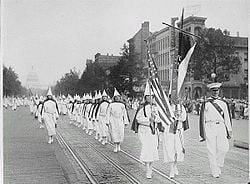
Folklorist and author Stetson Kennedy infiltrated the Klan after World War II and provided information on the Klan to media and law enforcement agencies. He also provided Klan information, including secret code words, to the writers of the Superman radio program, resulting in a series of four episodes in which Superman took on the KKK.[44] Kennedy's efforts to strip away the Klan's mystique and trivialize the Klan's rituals and code words had a negative impact on Klan recruiting and membership. He eventually wrote a book based on his experiences with the Klan, which became a bestseller during the 1950s and further damaged the Klan.[45]
Later Klans
After the breakup of the second Klan, the name "Ku Klux Klan" began to be used by several independent groups.
Beginning in the 1950s, a large number of the individual Klan groups began to resist the civil rights movement. This resistance involved numerous acts of violence and intimidation. Among the more notorious events of this time period were:
- The assassination in 1963 of NAACP organizer Medgar Evers in Mississippi. In 1994, former Ku Klux Klansman Byron De La Beckwith was convicted of Evers' murder.
- The 1966 firebombing death of NAACP leader Vernon Dahmer Sr., 58, also in Mississippi. In 1998 former Ku Klux Klan wizard Sam Bowers was convicted of Dahmer's murder. Two other Klan members were indicted with Bowers, but one died before trial, and the other's indictment was dismissed.
- The 1963 bombing of the 16th Street Baptist Church in Alabama, which killed four children. Four Klansmen were named as suspects; they were not prosecuted until years later. The Klan members were Robert Chambliss, convicted in 1977, Thomas Blanton and Bobby Frank Cherry, convicted of murder in 2001 and 2002. The fourth suspect, Herman Cash, died before he was indicted.
- The murder of Willie Edwards, Jr., in 1957. Edwards was forced by Klansmen to jump to his death from a bridge into the Alabama River.[46]
- The 1964 murders of civil rights workers Chaney, Goodman, and Schwerner in Mississippi. In June 2005, Klan member Edgar Ray Killen was convicted of manslaughter in the murders.[47]
- The 1965 murder of Viola Liuzzo, a Southern-raised white mother of five who was visiting the South from her home in Detroit to attend a civil rights march. At the time of her murder Liuzzo was transporting Civil Rights Marchers.
However, while the post-war Klan groups were extremely violent, it was also a period in which the Klan was successfully pushed back. For example, in a 1958 North Carolina incident, the Klan burned crosses at the homes of two Lumbee Native Americans who had associated with white people, and then held a nighttime rally nearby, only to find themselves surrounded by hundreds of armed Lumbees. Gunfire was exchanged, and the Klan was routed.[48]
Once the century-long struggle over black voting rights in the South had ended, the Klans shifted their focus to other issues, including affirmative action, immigration, and especially busing ordered by the courts in order to desegregate schools. In 1971, Klansmen used bombs to destroy ten school buses in Pontiac, Michigan, and charismatic Klansman David Duke was active in South Boston during the school busing crisis of 1974. Duke also made efforts to update its image, urging Klansmen to "get out of the cow pasture and into hotel meeting rooms." Duke was leader of the Knights of the Ku Klux Klan from 1974 until he resigned from the Klan in 1978. In 1980, he formed the National Association for the Advancement of White People, a white nationalist political organization. He was elected to the Louisiana State House of Representatives in 1989 as a Republican, even though the party threw its support to a different Republican candidate.
In this period, resistance to the Klan became more common. Jerry Thompson, a newspaper reporter who infiltrated the Klan in 1979, reported that in his brief membership in the Klan, his truck was shot at, he was yelled at by black children, and a Klan rally that he attended turned into a riot when black soldiers on an adjacent military base taunted the Klansmen. Attempts by the Klan to march were often met with counterprotests, and violence sometimes ensued.[49]
Vulnerability to lawsuits encouraged the trend away from central organization, as when, for example, the lynching of Michael Donald in 1981 led to a civil suit that bankrupted one Klan group, the United Klans of America.[50] Thompson related how many Klan leaders who appeared indifferent to the threat of arrest showed great concern about a series of multimillion-dollar lawsuits brought against them as individuals by the Southern Poverty Law Center as a result of a shootout between Klansmen and a group of African Americans, and curtailed their activities in order to conserve money for defense against the suits. Lawsuits were also used as tools by the Klan, however, and the paperback publication of Thompson's book was canceled because of a libel suit brought by the Klan.
Present
The Klan remains active today despite significant infighting which causes Klan groups to splinter and even runs to violence against their own leaders.[51]
Of the currently active Klan groups, the largest number subscribe to the beliefs of βtraditionalβ white supremacists: anti-black, anti-immigration, and homophobic. However, a growing number promote a Klan ideology infused with neo-Nazi beliefs.[51]
The current number of Klan members today is unknown, since the organizations do not reveal that information. The Anti-Defamation League (ADL) puts total Klan membership nationwide at around 3,000.[52]
Some of the larger KKK organizations currently in operation include:
- Bayou Knights of the Ku Klux Klan, prevalent in Texas, Oklahoma, Arkansas, Louisiana and other areas of the Southeastern U.S.
- Church of the American Knights of the Ku Klux Klan
- Imperial Klans of America
- Knights of the White Kamelia
- Knights of the Ku Klux Klan, headed by National Director Pastor Thom Robb, and based in Zinc, Arkansas. It refers to itself as the "sixth era Klan" and continues to be a racist group.
- Loyal White Knights of the Ku Klux Klan, a North Carolinaβbased group headed by Chris Barker.
- White Knights of the Ku Klux Klan
Despite the large number of rival KKK's, the media and popular discourse generally speaks of the Ku Klux Klan, as if there was only one organization.
Vocabulary
Membership in the Klan is secret, and the Klan, like many fraternal organizations, has signs members can use to recognize one another.
William Simmons, as part of his 1915 revival of the Klan, created terminology including many words beginning with "KL."[53]
The Reconstruction-era Klan used different titles; the only titles to carry over were "Wizard" (or Imperial Wizard) for the overall leader of the Klan, "Night Hawk" for the official in charge of security, and a few others, mostly for regional officers of the organization.
Notes
- β Stanley F. Horn, Invisible Empire: The Story of the Ku Klux Klan, 1866β1871 (Montclair, NJ: Patterson Smith Publishing Corp., 1939), 9.
- β Horn, 1939, 11, states that Reed proposed "ΞΊΟκλοΟ" ("kyklos") and Kennedy added "clan." Wyn Craig Wade. The Fiery Cross: The Ku Klux Klan in America. (New York: Simon and Schuster (original 1987), 33, says Kennedy came up with both words, but Crowe suggested transforming "ΞΊΟκλοΟ" into "kuklux."
- β Eric Foner, Reconstruction: America's Unfinished Revolution, 1863β1877 (Perennial (HarperCollins, 1989), 342.
- β Ku Klux Klan, Organization and Principles, 1868 Retrieved October 26, 2018.
- β Ku Klux Klan in the Reconstruction Era. New Georgia Encyclopedia. Retrieved October 26, 2018.
- β James Ford Rhodes, History of the United States from the Compromise of 1850 to the United States presidential election, 1896. Vol. 7 (of 8 vols)(The Macmillan Company, 1920), 157β158.
- β Michael Newton, The Invisible Empire: The Ku Klux Klan in Florida (University Press of Florida, 2001, ISBN 0813021200), 1β30. Newton quotes from the "Testimony taken by the Joint Select Committee to Enquire into the Condition of Affairs in the Late Insurrectionary States." Vol. 13. (Washington, DC: U.S. Government Printing Office, 1872). Among historians of the Klan, this volume is also known as "The KKK testimony."
- β Horn, 1939.
- β Allen W. Trelease, White Terror: The Ku Klux Klan Conspiracy and Southern Reconstruction ((original 1971) reprint ed. Louisiana State University Press, 1995, ISBN 031321168X).
- β Foner, 1989, 426.
- β Horn, 1939, 375.
- β Wade, 1987, 102.
- β Horn, 1939, 375.
- β Elaine Frantz Parsons, "Midnight Rangers: Costume and Performance in the Reconstruction-Era Ku Klux Klan." The Journal of American History 92(3) (2005): 816.
- β quotes from Wade, 1987.
- β Horn, 1939, 360.
- β Horn, 1939, 362.
- β 18.0 18.1 Richard Wormer, The Rise and Fall of Jim Crow β The enforcement acts (1870β1871) pbs.org. Retrieved October 26, 2018.
- β Wade, 1987, 85.
- β Foner, 1989, 435.
- β Wade, 1987.
- β Horn, 1939, 373.
- β Wade, 1987, 88.
- β Wade, 1987, 102.
- β Wade, 1987, 109, writes that by ca. 1871β1874, "For many, the lapse of the enforcement acts was justified since their reason for being β the Ku-Klux Klan β had been effectively smashed as a result of the dramatic showdown in South Carolina." Klan "costumes or regalia" had disappeared by the early 1870s. That the Klan was entirely nonexistent for a period of decades is shown by the fact that in 1915, Simmons's refounding of the Klan was attended by only two aging "former Reconstruction Klansmen" (Wade, 144). A PBS web page pbs.org. Richard Wormser in Jim Crow Stories states that "By 1872, the Klan as an organization was broken." Retrieved April 25, 2018
- β Wade, 1987, 109β110.
- β Foner, 1989, 437; and KKK Hearings, 46th Congress, 2d Session, Senate Report 693
- β Joe G. Taylor, Louisiana Reconstructed, 1863β1877 (Baton Rouge: Louisiana State University Press, 1974. ISBN 0807100846), 268β270.
- β Philip Dray, At the Hands of Persons Unknown: The Lynching of Black America (New York: Random House, 2002, ISBN 0375754458)
- β The Influence of "The Birth of a Nation" Facing History and Ourselves. Retrieved October 26, 2018.
- β Dray, 2002, 198. The comment was relayed to the press by Griffith and widely reported, and in subsequent correspondence, Wilson discussed Griffith's film making in a highly positive tone, without challenging the veracity of the statement.
- β Wade, 1987, 137.
- β Chester L. Quarles, The Ku Klux Klan and Related American Racialist and Antisemitic Organizations: A History and Analysis (McFarland, 2008), 219. The second Klan's constitution and preamble, reprinted in Quarles' book, states that the second Klan was indebted to the original Klan's Prescripts.
- β The quote is from the 1868 Revised Precept, from Horn, 1939.
- β Leonard J. Moore, Citizen Klansmen: The Ku Klux Klan in Indiana, 1921β1928 (Chapel Hill: University of North Carolina Press, 1991).
- β Kendall Latimer, KKK history challenges idea Sask. always welcomed newcomers: expert CBC, August 18, 2017. Retrieved October 26, 2018.
- β John Hope Franklin, Race and History: Selected Essays 1938β1988 (Louisiana State University Press (reprint edition), 1992), 145.
- β Greg Hernandez, It's been 70 years since Anaheim booted the Klan, Los Angeles Times, November 26, 1994. Retrieved October 26, 2018.
- β Glenn Feldman, Politics, Society, and the Klan in Alabama, 1915β1949 (Tuscaloosa, AL: University of Alabama Press, 1999).
- β William Rogers, Robert Ward, Leah Atkins, and Wayne Flynt, Alabama: The History of a Deep South State (Tuscaloosa, AL: University of Alabama Press, 1994), 437 and 442.
- β Rogers et al., 432β433.
- β Rogers et al., 433.
- β Leonard J. Moore, Citizen Klansmen: The Ku Klux Klan in Indiana, 1921β1928 (Chapel Hill, NC: University of North Carolina Press, 1991), 186.
- β Richard von Busack, Superman Versus the KKK MetroActive.com, 1998. Retrieved October 26, 2018.
- β Stetson Kennedy, The Klan Unmasked (University Press of Florida, 1990).
- β Major W. Cox, Justice Still Absent in Bridge Death. Major Cox Perspectives, March 2, 1999.
- β Kris Axtman, Mississippi verdict greeted by a generation gap The Christian Science Monitor, June 23, 2005. Retrieved October 26, 2018.
- β Emma DeWitt, New Battle, Old Challenges: The Lumbee Indians at the Battle of Hayes Pond. North Carolina History. Retrieved October 26, 2018.
- β Jerry Thompson, My Life in the Klan: the true story of the first investigative reporter to infiltrate the Ku Klux Klan (Nashville: Rutledge Hill Press, 1982, ISBN 0399126953), 1982.
- β Michael Donald Lynching Case. Southern Poverty Law Center. Retrieved October 26, 2018.
- β 51.0 51.1 ADL, Despite Internal Turmoil, Klan Groups Persist June 2017. Retrieved October 26, 2018.
- β Jay Reeves, At 150, KKK sees opportunities in US political trends Associated Press, June 30, 2016. Retrieved October 26, 2018.
- β Axelrod, 1997, 160.
ReferencesISBN links support NWE through referral fees
- Axelrod, Alan. The International Encyclopedia of Secret Societies & Fraternal Orders. New York: Facts On File, (1997) 1998. ISBN 0816038716.
- Blee, Kathleen M. Women of the Klan: Racism and Gender in the 1920s. University of California Press, 1992. ISBN 978-0520078765.
- Dray, Philip. At the Hands of Persons Unknown: The Lynching of Black America. New York: Random House, 2002. ISBN 0375754458.
- Egerton, John. Speak Now Against the Day: The Generation Before the Civil Rights Movement in the South. The University of North Carolina Press, 1995. ISBN 978-0807845578.
- Feldman, Glenn. Politics, Society, and the Klan in Alabama, 1915β1949. Tuscaloosa, AL: University of Alabama Press, 1999. ISBN 0817309845.
- Foner, Eric. Reconstruction: America's Unfinished Revolution, 1863β1877. (original 1988) Perennial HarperCollins, 1989. reprinted History Book Club ed. 2005. ISBN 0965727017.
- Franklin, John Hope. Race and History: Selected Essays 1938β1988. Louisiana State University Press (reprint edition), 1992. ISBN 0807117641.
- Horn, Stanley F. Invisible Empire: The Story of the Ku Klux Klan, 1866β1871. Montclair, NJ: Patterson Smith Publishing Corp., 1939.
- Horn was born in 1889, and was a Southern historian who was sympathetic to the first Klan.
- Ingalls, Robert P. Hoods: The Story of the Ku Klux Klan. New York: G.P. Putnam's Sons, 1979. ISBN 0399206582.
- Kennedy, Stetson. The Klan Unmasked. (original 1954) reprint ed. University Press of Florida, 1990. ISBN 0813009863.
- Levitt, Stephen D., and Stephen J. Dubner. Freakonomics: A Rogue Economist Explores the Hidden Side of Everything. New York: William Morrow, 2009. ISBN 978-0060731335.
- Moore, Leonard J. Citizen Klansmen: The Ku Klux Klan in Indiana, 1921β1928. (original 1980) Chapel Hill: University of North Carolina Press, 1991. ISBN 0807846279.
- Newton, Michael. The Invisible Empire: The Ku Klux Klan in Florida. University Press of Florida, 2001. ISBN 0813021200.
- Newton, Michael, and Judy Ann Newton. The Ku Klux Klan: An Encyclopedia. New York & London: Garland Publishing, 1991. ISBN 0824020383.
- Parsons, Elaine Frantz, "Midnight Rangers: Costume and Performance in the Reconstruction-Era Ku Klux Klan." The Journal of American History 92(3) (2005): 811β836.
- PBS. Freedom Never Dies: The legacy of Harry T. Moore. pbs.org. Retrieved October 26, 2018.
- Quarles, Chester L. The Ku Klux Klan and Related American Racialist and Antisemitic Organizations: A History and Analysis. McFarland, 2008. ISBN 0786438878.
- Rhodes, James Ford. History of the United States from the Compromise of 1850 to the McKinley-Bryan Campaign of 1896. Volume: 7. (1920)
- Winner of the Pulitzer Prize.
- Rogers, William; Ward, Robert; Atkins, Leah; and Flynt, Wayne. Alabama: The History of a Deep South State. Tuscaloosa, AL: University of Alabama Press, 1994. ISBN 0817307141.
- Steinberg, Alfred. Man From Missouri. New York: Van Rees Press, 1962.
- Taylor, Joe G. Louisiana Reconstructed, 1863β1877. Baton Rouge: Louisiana State University Press, 1974. ISBN 0807100846.
- "Testimony taken by the Joint Select Committee to Enquire into the Condition of Affairs in the Late Insurrectionary States." Vol. 13. Washington, D.C.: U.S. Government Printing Office, 1872.
- Thompson, Jerry. My Life in the Klan: the true story of the first investigative reporter to infiltrate the Ku Klux Klan. Nashville: Rutledge Hill Press, 1982. ISBN 0399126953.
- Trelease, Allen W. White Terror: The Ku Klux Klan Conspiracy and Southern Reconstruction. (original 1971) reprint ed. Louisiana State University Press, 1995. ISBN 031321168X.
- First published in 1971 and based on massive research in primary sources, this is the most comprehensive treatment of the Klan and its relationship to post-Civil War Reconstruction. Includes narrative research on other night-riding groups. Details close link between Klan and late nineteenth century and early twentieth century Democratic Party.
- Wade, Wyn Craig. The Fiery Cross: The Ku Klux Klan in America. New York: Simon and Schuster (original 1987). reprint Oxford University Press, 1998. ISBN 0195123573.
- An unsympathetic account of both Klans, with a dedication to "my Kentucky grandmother β¦ a fierce and steadfast Radical Republican from the wane of Reconstruction until her death nearly a century later."
External links
All links retrieved March 7, 2025.
Credits
New World Encyclopedia writers and editors rewrote and completed the Wikipedia article in accordance with New World Encyclopedia standards. This article abides by terms of the Creative Commons CC-by-sa 3.0 License (CC-by-sa), which may be used and disseminated with proper attribution. Credit is due under the terms of this license that can reference both the New World Encyclopedia contributors and the selfless volunteer contributors of the Wikimedia Foundation. To cite this article click here for a list of acceptable citing formats.The history of earlier contributions by wikipedians is accessible to researchers here:
The history of this article since it was imported to New World Encyclopedia:
Note: Some restrictions may apply to use of individual images which are separately licensed.
